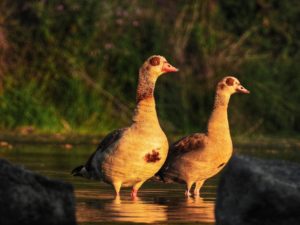Halloween is just around the corner, so let’s scare up some fun with a look at birds people might find downright scary, and/or birds that naturally sport a spooky style.
The Shoebill Stork

Olaf Oliviero Riemer, CC BY-SA 3.0 <https://creativecommons.org/licenses/by-sa/3.0>, via Wikimedia Commons
There’s no doubt that the shoebill stork (Balaeniceps rex) can strike an intimidating stare. Throw in its massive size (between 3 1/2 and 4 1/2 inches!), this long-legged bird that inhabits the large swamps between South Sudan to Zambia, can certainly give one a freight. Add to this the fact that the shoebill has a tendency to stay perfectly still for stretches at time, making it seem almost statue-like. Imagine this bird staring you down in a swampy marsh at sundown!
Good thing you’re not on the shoebill’s menu. Shoebills prefer lungfish, tilapia, catfish, and other aquatic prey. This bird’s hunting style is to perch on floating vegetation, then patiently and slowly wades in the water to stalk its prey before launching a quick and violent strike.
If the shoebill’s intimidating stare and creepy way of hunting its prey aren’t scary enough for you, its vocalization might send you ducking for cover. The shoebill’s greeting sounds like machine-gun fire!
But is the shoebill a bird to fear? Thankfully, shoebills are docile with humans and show no threatening behavior.
The Bleeding Heart Dove

When you first see a bleeding heart dove, your first thought might be, “Poor thing!” Yes, this bird looks like it took a bullet to the chest, with a prominent red circle of feathers featured squarely in the middle of its front side. But before you make a move to render aid, know that this is simply part of the bleeding heart pigeon’s look—blood-splattered-looking feathers offset its otherwise chest full of white feathers. It’s a dramatic look for sure, and one that makes for nature’s perfect Halloween costume.
Egyptian Goose

You might be used to the site of Canada geese foraging on the park grass near your home, but did they turn into zombies overnight? Rest assured, there’s no zombie apocalypse in your town and those reddish-eyed creatures are not Canada geese. You are looking at Egyptian geese. The Egyptian goose – also called the Nil goose – is named after the Nile Valley in Africa, where it originates. You can find these non-native waterfowl in North America though. They’ve now seen in California, Florida, Georgia, and Texas.
The Dracula Parrot

Finally, we come to perhaps the scariest-sounding bird of them all—a goth-looking parrot nonetheless. The Dracula parrot (also known as Pesquet’s parrot (Psittrichas fulgidus) is found only in the cloud forests in the foothills and lower mountains of New Guinea, has a parrot’s body and a vulture-like head. Its featherless head is said to serve a similar function to that of a vulture. Like a vulture, this parrot also digs head-first into its food. But it’s not a carcass like a vulture does—it’s an adaption to avoid feather-matting from sticky fruits.

3 Comments